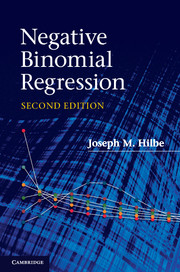Book contents
- Frontmatter
- Contents
- Preface to the second edition
- 1 Introduction
- 2 The concept of risk
- 3 Overview of count response models
- 4 Methods of estimation
- 5 Assessment of count models
- 6 Poisson regression
- 7 Overdispersion
- 8 Negative binomial regression
- 9 Negative binomial regression: modeling
- 10 Alternative variance parameterizations
- 11 Problems with zero counts
- 12 Censored and truncated count models
- 13 Handling endogeneity and latent class models
- 14 Count panel models
- 15 Bayesian negative binomial models
- Appendix A Constructing and interpreting interaction terms
- Appendix B Data sets, commands, functions
- References and further reading
- Index
15 - Bayesian negative binomial models
Published online by Cambridge University Press: 05 June 2012
- Frontmatter
- Contents
- Preface to the second edition
- 1 Introduction
- 2 The concept of risk
- 3 Overview of count response models
- 4 Methods of estimation
- 5 Assessment of count models
- 6 Poisson regression
- 7 Overdispersion
- 8 Negative binomial regression
- 9 Negative binomial regression: modeling
- 10 Alternative variance parameterizations
- 11 Problems with zero counts
- 12 Censored and truncated count models
- 13 Handling endogeneity and latent class models
- 14 Count panel models
- 15 Bayesian negative binomial models
- Appendix A Constructing and interpreting interaction terms
- Appendix B Data sets, commands, functions
- References and further reading
- Index
Summary
Bayesian versus frequentist methodology
Bayesian statistics has continually been growing in popularity since the 1980s. Currently there are societies devoted to Bayesian methodology, and the major statistical associations typically have committees devoted to the promotion of Bayesian techniques. In the discipline of astrostatistics, for example, the majority of articles related to the statistical analysis of astronomical data employ some type of Bayesian approach. Not all disciplines are so committed to Bayesian methodology of course, but it is the case that there are a growing number of researchers who are turning to Bayesian modeling. In this chapter we shall present a brief overview of this approach, and give an example of a Bayesian negative binomial model.
Bayesian statistics is named after Thomas Bayes (1702–1761), a British Presbyterian minister and amateur mathematician who was interested in the notion of inverse probability, now referred to as posterior probability. The notion of posterior probability can perhaps best be understood with a simple example.
Suppose that 90% of the students in a statistics course pass. Students who passed are given the symbol P; students who failed are given an F. Therefore, 10% of the students failed the course. Everyone who passed purchased the course text, while only half of the students who failed did so. Let's suppose we observe a student with the course text (assume they purchased it). What is the probability that this student failed? This is an example of posterior probability.
- Type
- Chapter
- Information
- Negative Binomial Regression , pp. 502 - 519Publisher: Cambridge University PressPrint publication year: 2011
- 1
- Cited by



